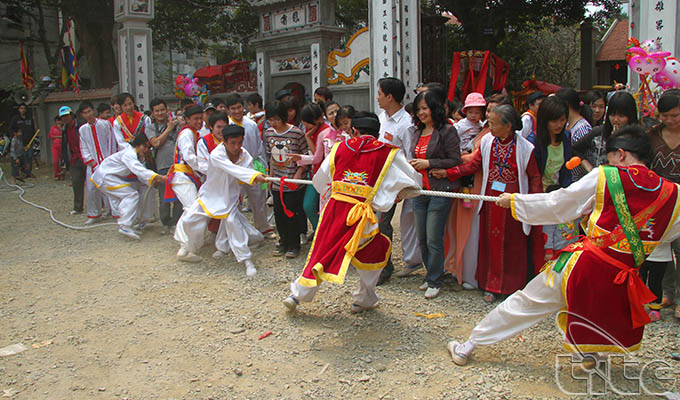(TITC) - Tugging is a longstanding and popular form of community activity in rice farming cultures in East Asia and Southeast Asia, typically the Republic of Korea, Cambodia, Philippines and Viet Nam.
Characteristics
Tugging is a social ritual with the purpose of wishing for rainfall required for agriculture and bountiful harvests or fortune-telling with regards to the success or failure of farming efforts. It is believed that practicing and obeying to the rules of tugging ritual will help abundant harvests, prosperity and happiness. So, not only as a common folk game, tugging also contains deep culture values expressing through own customs and beliefs of each country.
In Viet Nam, tugging rituals and games are concentrated mostly in the Northern Midlands, the Red River Delta, and the North Central, which are the ancient land of the Viet and the cradle of the native wet rice culture. In addition, they are regularly practiced by ethnic groups in the Northern Mountains, such as Tay, Thai, and Giay.

Held as a part of the spring festivals, marking the beginning of a new agricultural cycle and expressing wishes for bumper crops, Tugging rituals and games generally entail the participation of almost all members in the community, each member plays distinct role such as practitioners, guiders, observers, transmitters, supporters, etc. Of which, the elders, especially ritual specialists, always play significant roles delegating duties, guiding the rules of the tugging games, and play the key role in other related rites.
Tugging rituals and games are often organized in front of a village’s communal house. The materials used in tugging vary from region to region; they can be made of bamboo poles, rattan cords, or hemp, reflecting the ecological and cultural context of each community. Each tugging game has the participants of two teams with equal number of members. The two teams will hold tightly two ends of a rope marked by a red ribbon in the middle. When tugging game begins, the members of each team will try to pull the rope. The winning team must pull the red-ribbon mark on its side.
In tugging rituals and games, the selection procedures for the tugging rope and contenders follow particular ritual rules and local customs. The winning team and the losing team are often arranged by custom to express certain religious meanings and the harmony of nature. For example, the tugging rituals and games of the Tay and Giay allow the teams to be a mix of genders, and efforts are made to ensure that the women’s team wins on even-numbered years, which symbolizes reproduction and fertility.
Outstanding values
As a favourite folk game, tugging is promoted widely in contemporary life. It is appealing to people of all ages and strata because it is easy to play. Although it has a competitive component, but winning or losing is not as important as unity, joy, and community harmony.
Beliefs and rituals are the core values of tugging expressed through rules of selection procedures for the tugging rope and contenders as well as conventions. Thereby, the tugging bears the traces of agricultural rituals, symbolizing the strength of natural forces such as sun and rain.
In each country, tugging rituals and games have significant differences in their scale, complexity and historical background. In Viet Nam, tugging reflects agricultural identity through symbolic acts. In some localities, it is also closely linked to the stories of defied heroes who had contributions in fighting invaders and defending people’s prosperous life.
Tugging is mostly transmitted orally and through hands-on experience. The elderly guide the ritual and symbolic aspects for younger generations. The tugging skills and techniques are transmitted from generation to generation with a sense of pride and responsibility.
Practicing tugging rituals and games
In Viet Nam, the representative communities for practicing tugging rituals and games include the Kinh people in Huong Canh Town (Binh Xuyen District, Vinh Phuc Province), Huu Chap Village (Hoa Long Commune, Bac Ninh City, Bac Ninh Province), Thach Ban Ward (Long Bien District, Ha Noi City), Xuan Lai Hamlet (Xuan Thu Commune, Soc Son District, Ha Noi City); Tay people in Trung Do Hamlet (Bao Nhai Commune, Bac Ha District), Giay people in Ta Van Giay Hamlet (Ta Van Commune, Sa Pa District), Thai people in Ban Ngoang Hamlet (Tham Duong Commune, Van Ban District) of Lao Cai Province.
On 2 December 2015, at the 10th session of the Intergovernmental Committee for Safeguarding of the Intangible Cultural Heritage of UNESCO held in Windhoek City, Republic of Namibia, Tugging rituals and games in Cambodia, the Republic of Korea, the Philippines, and Viet Nam have been officially recognized as Intangible Cultural Heritage of Humanity.
Thu Giang